Hpw to Use: Dji Goggles Racing Digital Video FPV system User Manual | Specifications
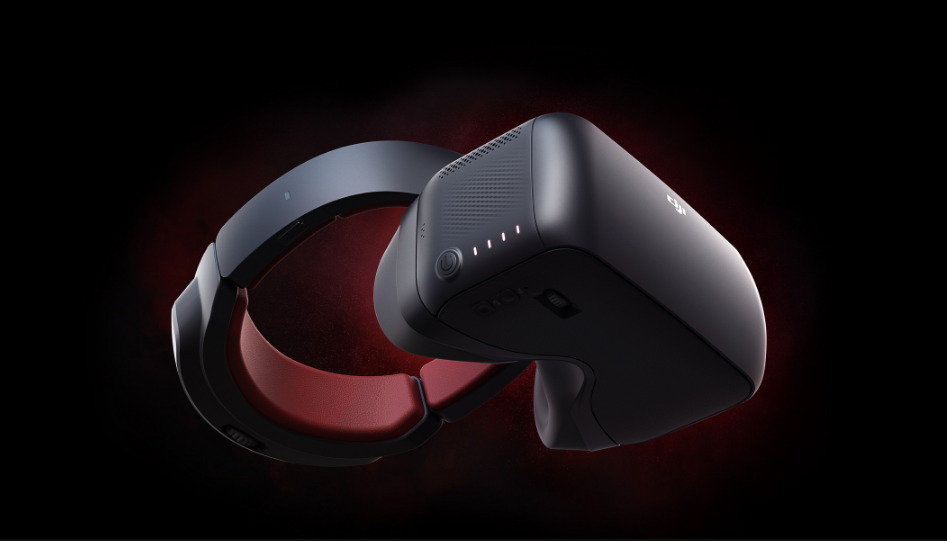
Content
Introduction
The DJI Goggles Racing Digital Video FPV system is equipped w th high-performance displays and an ultra-low latency video downlink for use with DJI aircraft, giving you a real-time aerial FPV (First Person View) experience. Goggles RE can also be used to play HD videos, offering an immersive high-definition viewing experience.
Precisely engineered for racing, Goggles RE are compatible with DJI's advanced OCUSYNCTM video transmission module, supporting both analog and 2.4/5.8 GHz dual-band digital video signal with up to 7 km transmission distance and latency as low as 50 ms.* Goggles RE comes with a set of three compatible antennas for different scenarios. The DJI OcuSync Air System comes equipped with an array of powerful features, such as 1280×960 HD transmission, automatic Frequency-Hopping Spread Spectrum (FHSS) transmission, and access to up to 19 selectable transmission channels. This module is compatible with a variety of multi-rotor and fixed-wing aircraft.
The DJI Goggles Racing Edition (RE) is a high-performance digital video FPV system designed for drone racing enthusiasts. Featuring ultra-low latency video transmission and high-resolution displays, these goggles provide an immersive first-person view experience. The Goggles RE support both analog and digital video signals, allowing for seamless integration with various DJI drones. With a sleek design and comfortable fit, they enhance the thrill of racing. The cost of the DJI Goggles Racing Edition is $469.00.
DJI Goggles Racing Edition
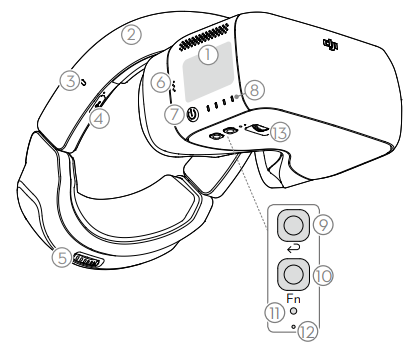
- Touch Panel
- Headband
- Charging Status Indicator
- Micro USB Port
- Headband Knob
- Speaker
- Power Button
- Battery Level Indicators
- Back Button
- Function Button
- Link Button
- Linking Status Indicator
- IPD (Interpupillary Distance) Knob
- Lens
- Proximity Sensor
- Headband Buckle
- Heat Vent
- Micro SD Card Slot
- 3.5 mm Audio Port
- HDMI Type-D Port
- Speaker
- SMA Antenna Port

DJI OcuSync Air Unit

- Camera Port
Connects to the DJI OcuSync Camera. - S.Bus Port
Connects with the 3-in-1 Cable (Power, S.Bus, UART), and connects to the power, flight controller, and OSD port based on the information below:- RED: Power
- BLACK: Power GND
- WHITE: UART RX (Connects to OSD TX)
- GRAY: UART TX (Connects to OSD RX)
- BROWN: Signal GND
- YELLOW: S.Bus (Connects to Flight Controller RX)
- Micro SD Card Slot
Insert the Micro SD card to store the recorded video. - Antenna Ports (MMCX)
Used to attach the Air Unit antennas. - Micro USB Port
Connects to your PC for firmware updates through DJI Assistant 2 (When the Air Unit is powered on). - PPM Port
Connects to external devices that can handle PPM signals via the PPM Cable. Set the corresponding channel in DJI Goggles RE to control the device remotely with head movements (coming soon).- RED: Power
- BLACK: Signal GND
- WHITE: PPM signal
- Link Button
Press this button to link the OcuSync Air Unit with the Goggles RE. - Linking Status Indicator
Indicates the linking status of the DJI OcuSync Air Unit and the Goggles RE.
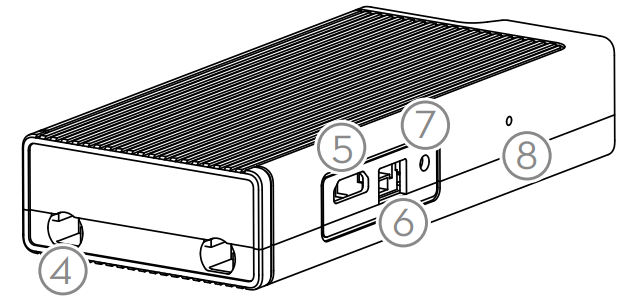
DJI Goggles Racing Digital Video FPV System Specifications
DJI Goggles RE
- Weight (Typical):
Goggles RE Body: 502 g
Headband: 500 g - Dimensions:
Goggles RE Body: 195×155×110 mm
Headband (folded): 255×205×92 mm - Screen Size: 5 inch × 2
- Screen Resolution: 3840×1080 (single screen: 1920×1080)
- Refresh Rate: 60 Hz
- FOV: 85° (single screen)
- Interpupillary Distance Range: 58 – 70 mm
- Communication Frequency: 2.4 GHz / 5.8 GHz
- Transmitter Power (EIRP):
2.4 GHz: 25.5 dBm (FCC); 18.5 dBm (CE); 19 dBm (SRRC)
5.8 GHz: 25.5 dBm (FCC); 12.5 dBm (CE); 18.5 dBm (SRRC) - Max. Transmission Distance: Same as the aircraft connected
- Live View Modes: 1080p30, 720p60, 720p30
- Min. Video Downlink Latency:
140 ms (Mavic 2 Series, 720p30, video format: 1080p60)
110 ms (Mavic Pro, 720p60, video format: 720p120)
180 ms (Mavic Air, 720p30, video format: 720p120)
150 ms (Spark, 720p30, video format: 1080p30)
110 ms (Phantom 4 Pro/Pro+ V2.0, 720p60, video format: 720p120)
150 ms (Phantom 4 Pro/Advanced Series, 720p60, video format: 720p60/720p120)
167 ms (Phantom 4, 720p30, video format: 720p60)
140 ms (Inspire 2+X5S, 720p60, video format: 1080p120)
190 ms (Inspire 2+X4S, 720p60, video format: 1080p60) - Video Format: MP4 (H.264)
- Supported Video Play Format: MP4, MOV, MKV, AVI, FLV, 3GP, MPG, TS
(Video format: H264, H263, MPEG4, MPEG2, MPEG1; Audio format: AAC, AC-3, EAC3, DTS, MP3, MP2, Vorbis, PCM) - I/O Interface: SMA port, Micro USB port, 3.5 mm Audio port, HDMI Type-D port, Micro SD Card slot
- HDMI Supported: HDMI 1.4b, HDCP 1.4
- Sensors: Gyroscope, Accelerometer, Proximity Sensor
- Operating Temperature Range: 32° to 104° F (0° to 40° C)
- Battery Capacity: 9440 mAh
- Battery Energy: 35.44 Wh
- Max. Operating Time: 6 hrs
- Charger Input: 100-240 VAC, 50/60 Hz, 0.5 A
Output: 5 V 3 A / 9V 2A / 12 V 1.5 A
DJI OcuSync Air System
- Weight:
Air Unit: 43.7 g
Camera (cable included): 18.2 g
Pagoda Antenna: 9.4 g
Cylindrical Antenna: 9.4 g
Dipole Antenna: 4.2 g - Dimensions:
Air Unit: 72 × 33 × 14 mm
Camera: 29.4 × 28.2 × 22.6 mm - Communication Frequency: 2.4 GHz / 5.8 GHz
- Transmitter Power (EIRP):
2.4 GHz: 22.5 dBm (FCC); 18.5 dBm (CE); 19 dBm (SRRC)
5.8 GHz: 25.5 dBm (FCC); 12.5 dBm (CE); 25.5 dBm (SRRC) - Live View Modes and Min. Latency:
960p50: 70 ms
720p60: 60 ms
480p50: 50 ms - Max. Transmission Distance:
2.4 GHz: 7 km (FCC); 4 km (CE); 4 km (SRRC)
5.8 GHz: 4 km (FCC); 0.7 km (CE); 4 km (SRRC) - Recommended Frequency Band:
FCC: 5.8 GHz
CE: 2.4 GHz
SRRC: 5.8 GHz - Video Format: MP4 (MPEG4)
- I/O Interface: S.Bus, Micro USB, PPM, UART, MMCX, Micro SD card slot
- Supported Flight Control System: F3, F4, KISS, NAZE
- Supported Remote Controller: X9D (Frsky), DEVO 10 (Walkera), T8FG (Futaba), T14SG (Futaba), WTF09sll (WFLY), AT9S (RadioLink)
- Operating Temperature Range: 32° to 104° F (0° to 40° C)
- Input Power: 9-16.8 V (3S-4S)
- Camera
Sensor: 1/3'' CMOS; Effective pixels: 1.2M
Lens: 2.65 mm, f/2.0
Lens Group: 6G + IR
Shutter: Global shutter
ISO: 100 - 3200
FOV: 148° (D); 111° (H); 79.5° (V)
Installation and Wearing
Insert the Headband into the slot above the Goggles RE body until you hear a click. Now check that it has been securely fastened. Press the Headband Buckle and move it in the opposite direction to release the Headband.
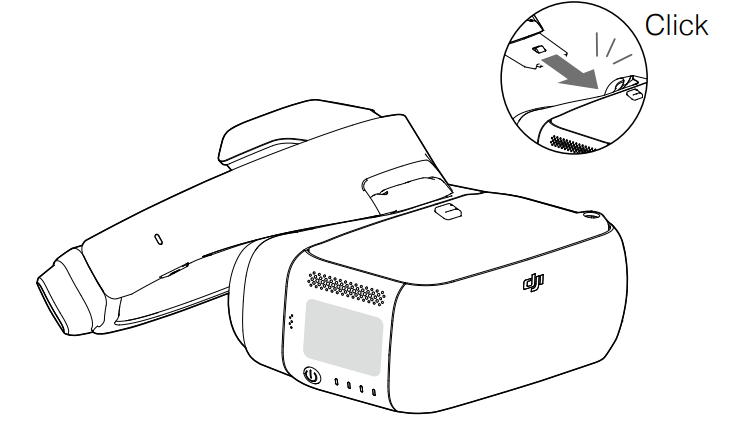
Align the lenses over your eyes and pull the Headband down. Adjust the Headband Knob until the Goggles RE fit snugly and comfortably on your face and head. Goggles RE can be worn over glasses. When putting the Goggles RE on, you can flip the Goggles RE body to see the world outside.

Turn the IPD Knob to adjust the distance between the lenses until the images are properly aligned.
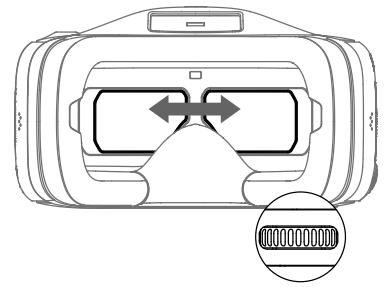
Usage
Operating Control
Power Button
Press the power button once, then press it again and hold to turn the Goggles RE on/off. The battery level indicators will display the current battery level.
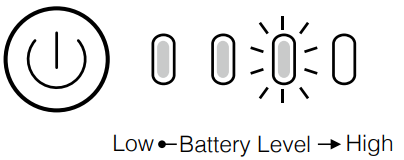
Battery Level Indicators
When the battery is powered off, press the power button once to light up the battery level indicators to display the current battery level. The battery level indicators will also show the current battery level during charging and discharging.
The indicators are defined below:

Touch Panel
Use the touch panel with your right hand to control on-screen operations.
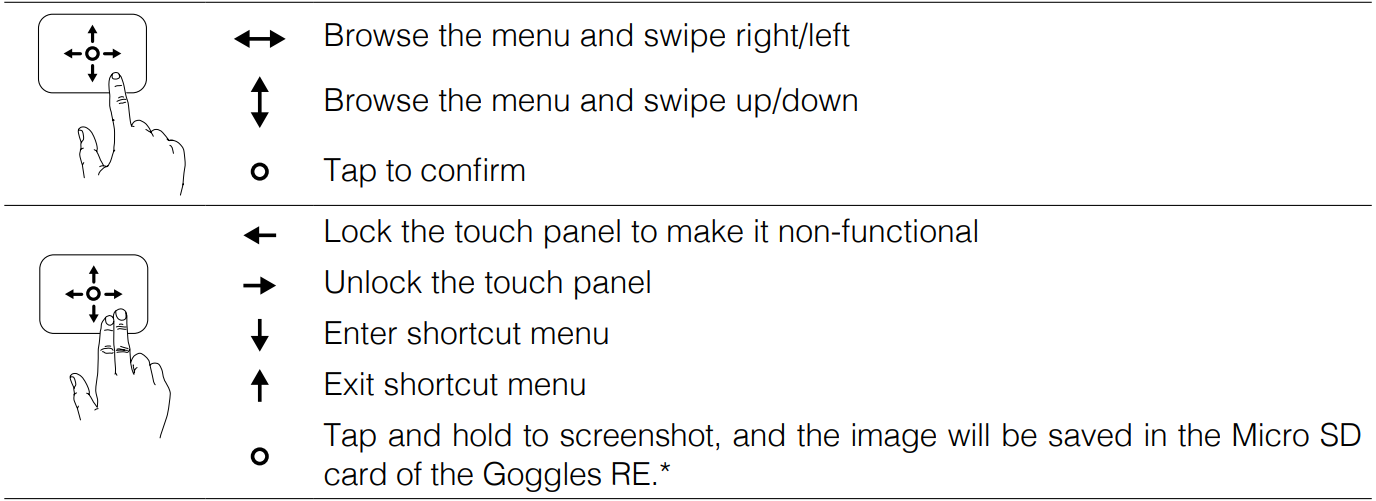
Charging Status Indicator
This indicates the current charging status. The LED will be solid red, yellow, or green to reflect low, medium, and high power levels, respectively:
- Blinking Red: Headband abnormal
- Solid Red: 0~29%
- Solid Yellow: 30~89%
- Solid Green: 90~100%
Back Button
Press this to return to the previous menu, or exit the current Intelligent Flight Mode.
Function Button
For DJI aircraft that support focus (e.g., MAVICTM Pro, PHANTOMTM 4 Pro), press this to show the focus cursor on the display screen and swipe forward and backward on the touch panel with one finger to zoom in or out. Move your head, then tap the touch panel to define the focus point.
For other third-party devices when using digital video transmission, press to start or stop video recording. The Goggles RE support up to 4x zoom on the Mavic Pro.
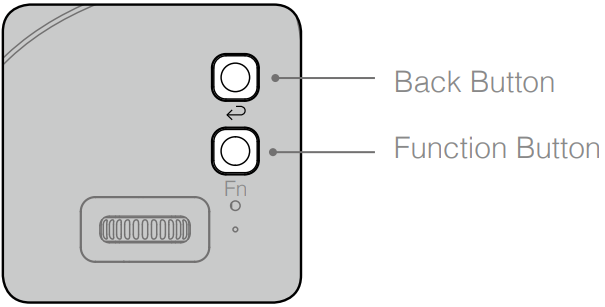
Link Button
When connected with the aircraft by OCUSYNCTM, press the link button with an appropriate tool to start linking.
Linking Status Indicator
Indicates the linking status of the Goggles RE and the aircraft. The indicator will be solid red while linking and will go solid green when linked.
Description
The DJI Goggles Racing Edition is built with durability and comfort in mind. The ergonomic design ensures that the goggles fit snugly around your head, reducing fatigue during extended use. The dual screens provide a crystal-clear visual experience, while the built-in speakers offer an immersive audio experience. The goggles are also compatible with a variety of DJI drones and transmitters, making them versatile for different flying needs.
Connection of DJI Goggles Racing Digital Video FPV system
Goggles RE Support
Goggles RE supports the DJI OcuSync Air System, third-party analog video transmitters, and a wide range of DJI aircraft for different uses. Please follow the steps below for connecting with these devices.
Analog Video Transmitter
The analog frequency band is 5.650 GHz - 5.925 GHz. This range supports various third-party analog transmission devices and can be used in scenarios such as racing drones, controlling model aircraft, ships, and other vehicles.
Linking Method
Install the Pagoda antenna (SMA interface) to the Goggles RE’s SMA port.

- Power on the Goggles RE, swipe downward with two fingers on the touch panel to enter the shortcut menu, and select “Racing Drone (Analog) > Frequency Scanning” to search for the frequency you need. The analog frequency band is 5.650 GHz - 5.925 GHz, of which 5.725 GHz - 5.850 GHz are ISM frequency bands. You may use these frequencies without permission, but please ensure you have the relevant license and follow local regulatory procedures when using the other frequency bands.
The Pagoda antenna is an omnidirectional left-hand circularly polarized (LHCP) antenna design. It is recommended to use the Pagoda antenna or other left-hand circularly polarized antennas for analog transmitters to achieve the best transmission performance. In a multi-aircraft flying environment, the adjacent frequency interval should be higher than 25 MHz to avoid nearby frequencies affecting the live view of your Goggles RE.
DJI OcuSync Air System
The Goggles RE's built-in DJI OcuSync dual-band wireless receiver is compatible with the DJI OcuSync Air System, which you can install on a third-party device to transmit digital video signals. Digital video transmission supports 1280 × 960p50, 1280 × 720p60, and 640 × 480p50, as well as automatic Frequency-Hopping Spread Spectrum (FHSS) transmission. Digital video transmission can also access up to 19 selectable transmission channels, which can be used for racing drones, model aircraft, ships, and other vehicles, as well as for industrial use.
Basic Linking
Install the Pagoda antenna (SMA interface) to Goggles RE’s SMA port.
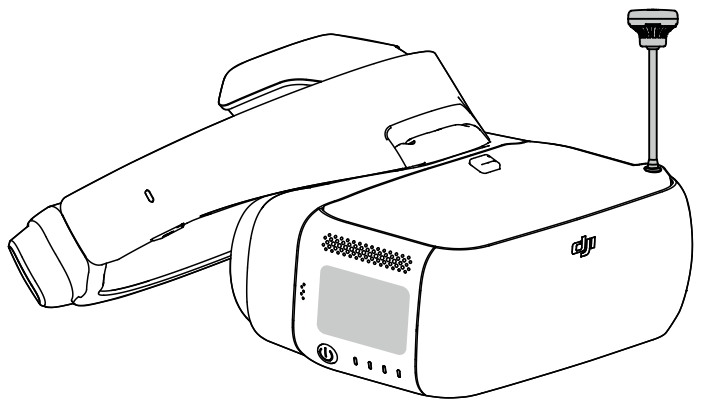
Install the DJI OcuSync Air System on a third-party device to link with the Goggles RE. Refer to the illustration below to mount and connect the components onto your device.
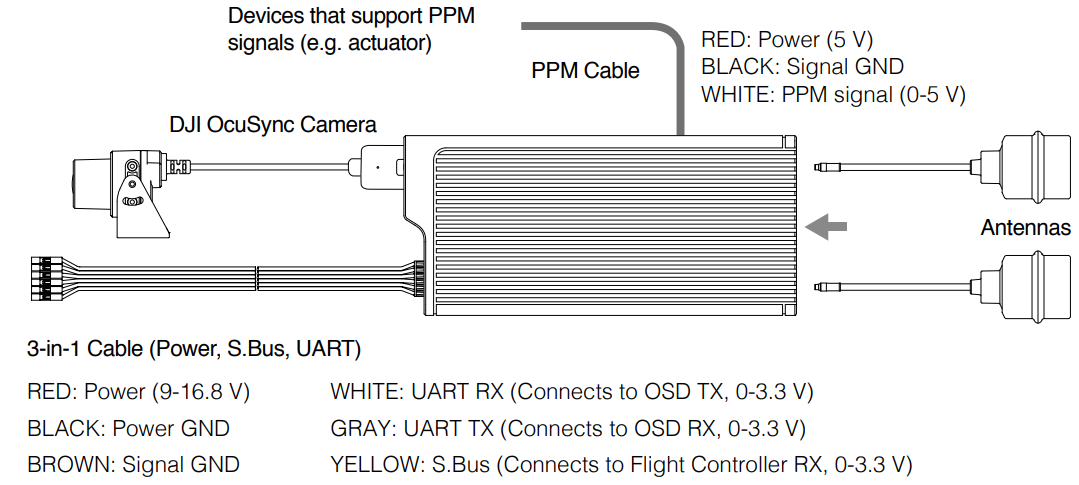
- The S.Bus port and PPM port on the Air Unit are only used when transmitting remote control signals. These ports don’t need to be connected if only using video downlink.
- There are up to 19 channels (5.8 GHz: 12 channels; 2.4 GHz: 7 channels) for digital video transmission, and each bandwidth is 10 MHz. You can manually select the transmission channel to avoid interference from other devices.
Please note- The Air Unit may become very hot during or after operation. DO NOT touch the Air Unit before it has sufficiently cooled down.
- Avoid using the Air Unit for an extended period of time when there is no external cooling equipment, as this may cause the Air Unit to enter Overheat Protection mode. Wait for the module to cool down and then restart it. It is recommended to have an external fan installed to dissipate heat.
- Place the two antennas on the Air Unit vertically and parallel to each other at least 30 mm apart. Avoid placing the antennas level with any electrically conductive material. Also, keep the bottom of the antenna at least 25 mm away from potential conductors such as cables, carbon fiber frames, batteries, and metals.
- If you are only using the Air Unit to transmit downstream video signals, DO NOT use the same frequency band as the upstream control signal to avoid interference.
- Power on the DJI OcuSync Air Unit and press the link button on the Air Unit with an appropriate tool when the linking status indicator is solid green. The indicator will turn solid red when the Air Unit is waiting for linking.
- Power on the Goggles RE, then press the link button with an appropriate tool in the main menu, or swipe down on the touch panel with two fingers to enter the shortcut menu and select “Racing Drone (Digital) > Linking Settings > Quick Linking.”
- Make sure the distance between Goggles RE and the Air Unit is within 2 meters. Both linking status indicators will turn solid green when successfully linked, and the video will display normally.
Multi-Device Linking
The DJI OcuSync Air System supports linking two devices to receive video transmission at the same time. Below are two specific scenarios.
Two Goggles RE
- Follow steps 1 and 2 of “Basic Linking” above to complete the linking of Goggles RE and the DJI OcuSync Air System.
- Power on the DJI OcuSync Air Unit and press the link button on the Air Unit with an appropriate tool when the linking status indicator is solid green. The indicator will turn solid red when the Air Unit is waiting for linking.
- Power on the first Goggles RE, swipe down on the touch panel with two fingers to enter the shortcut menu, then select “Racing Drone (Digital) > Linking Settings > Advanced Linking > Connect two sets of Goggles RE > Primary” and confirm. This Primary Goggles RE will be linked with the DJI OcuSync Air System in a few seconds.
- Press the link button on the Air Unit again. The indicator will turn solid red when the Air Unit is waiting for linking.
- Power on the second Goggles RE, swipe downward with two fingers on the touch panel to enter the shortcut menu, select “Racing Drone (Digital) > Linking Settings > Advanced Linking > Connect two sets of Goggles RE > Secondary” and confirm. This Secondary Goggles RE will be linked with the DJI OcuSync Air System in a few seconds.
Goggles RE + Mavic Pro Remote Controller:
- Follow steps 1 and 2 of “Basic Linking” above to complete the linking of Goggles RE and the DJI OcuSync Air System.
- Power on the Goggles RE, swipe down on the touch panel with two fingers to enter the shortcut menu, select “Racing Drone (Digital) > Wireless Settings > Auto”, and set 2.4 GHz as the operating frequency, since this is the only frequency that the Mavic Pro Remote Controller supports.
- Power on the DJI OcuSync Air Unit and press the link button on the Air Unit with an appropriate tool when the linking status indicator is solid green. The indicator will turn solid red when the Air Unit is waiting for linking.
- Put on Goggles RE, select “Racing Drone (Digital) > Linking Settings > Advanced Linking > Connect two sets of Goggles RE > Primary” and confirm. This Primary Goggles RE will be linked with the DJI OcuSync Air System in a few seconds.
- Press the link button on the Air Unit again. The indicator will turn solid red when the Air Unit is waiting for linking.
- Connect your mobile device to the Mavic Pro Remote Controller, launch the DJI GOTM 4 app, and enter the camera view. Press
 , then select “Remote Controller Linking > Secondary Remote Controller.” The Remote Controller will be linked with the DJI OcuSync Air System in a few seconds.
, then select “Remote Controller Linking > Secondary Remote Controller.” The Remote Controller will be linked with the DJI OcuSync Air System in a few seconds.
Note:
You can only view video transmission on the mobile device linked to the Mavic Pro Remote Controller. Upstream control signal transmission is not supported.
After familiarizing yourself with digital video transmission, you can connect the trainer port on a third-party remote controller and the audio port on the Goggles RE with a trainer cable to transmit the control signal to a racing drone. Additionally, the PPM port of the DJI OcuSync Air Unit can be connected to the gimbal actuator, enabling gimbal control through your head movements.
DJI Aircraft using OcuSync
With OcuSync, the Goggles RE can be connected to the Mavic 2 series, Mavic Pro, or the Phantom 4 Pro/Pro+ V2.0 wirelessly. Toggle the control mode switch of the Mavic Pro to RC mode before linking. Ensure that the DJI GO 4 app is updated to the latest version. The Mavic 2 series and Phantom 4 Pro/Pro+ V2.0 currently only support linking with Goggles RE by Standard Mode.
Standard Mode
Standard Mode is suitable for both single and dual operator aircraft control. In this mode, the pilot using the remote controller can focus on flight, while the Goggles RE operator can view the environment in real-time FPV for more intuitive control. By moving their head, the Goggles RE wearer can control aircraft orientation or gimbal movement.
If the remote controller and Goggles RE are operated by the same user, a spotter who is able to give instructions and warnings is required to ensure safe flying.
In Head Tracking Flight, aircraft yaw can be controlled by both the Goggles RE and the remote controller. With Head Tracking Gimbal, the gimbal will only move with the movement of the Goggles RE.

Linking Method
- Ensure both the aircraft and the remote controller are powered on and linked.
- Put on the Goggles RE and power on.
- Press the link button on the Goggles RE or use the touch panel to enter “Tools > Settings > Linking Settings”, select “Quick Linking” and confirm. The Goggles RE linking status indicator will go solid red on standby for linking.
- Press the link button on the aircraft. Once linked, the Goggles RE linking status indicator will turn solid green.
Coach Mode
Coach Mode is suitable for dual operator aircraft control. In this mode, the pilot using the remote controller can focus on flight, while the Goggles RE operator with a secondary remote controller can view the environment in real-time FPV for more intuitive control. By moving their head, the Goggles RE wearer can control aircraft orientation or gimbal movement. They can also control the aircraft with the auxiliary secondary remote controller that is inferior to the priority control of the primary remote controller.
Please note that only the DJI GO 4 app connected with the primary remote controller and the Goggles RE can display the live view.
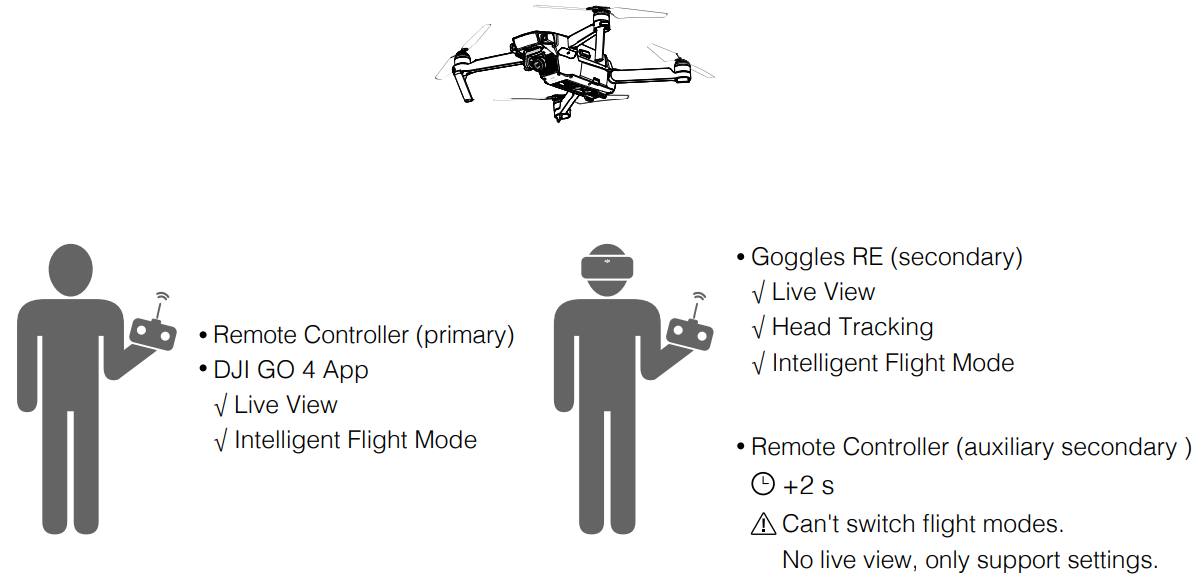
Warning
- Only the primary remote controller can switch flight modes.
- If two operators control the aircraft simultaneously, the commands from the primary remote controller take priority for aircraft movements (control sticks and gimbal dial). The auxiliary secondary remote controller only works if the primary remote controller is not being operated for more than two seconds, whereas the primary remote controller can always override it to regain control. The two remote controllers follow the same priority for other commands.
- If the Goggles RE are powered off or disconnected from the aircraft for more than 30 seconds during flight, the Goggles RE's corresponding secondary remote controller will replace it to control the aircraft. Note that there is still no live view on the DJI GO 4 app connected to the secondary remote controller.
Linking Method
- Ensure both the aircraft and the primary remote controller are powered on and linked together.
- Put on the Goggles RE and power on.
- Use the touch panel to enter “Tools > Settings > Linking Settings.”
- Select “Advanced Linking > Connect one set of Goggles RE” and confirm. The Goggles RE linking status indicator will go solid red to wait for linking.
- Press the link button on the aircraft. Once linked, the linking status indicator will turn solid green.
- Select “Connect Remote Controller” and confirm in Goggles RE.
- Power on the auxiliary secondary remote controller and connect it with the mobile device.
- Launch the DJI GO 4 app and enter the camera view. Press, then select “Remote Controller Linking > Secondary Remote Controller,” for successful linking in a few seconds.
Multiuser Mode
Multiuser Mode is suitable for dual (or more) aircraft operator control. In this mode, the Goggles RE operators with a secondary remote controller can view the environment in real-time FPV for more intuitive control. Please note that only the Goggles RE will display live view, and that the primary Goggles RE only support head tracking.

Warning
- If the remote controller and Goggles RE are operated by one person but for two users, a spotter who is able to instruct and give warnings is required for safe flying.
- Only the primary remote controller can switch flight modes.
- Secondary Goggles RE do not support head tracking.
- If two operators control the aircraft simultaneously, the commands from the main secondary remote controller take priority for aircraft movements (control sticks and gimbal dial). The auxiliary secondary remote controller only works if the main secondary remote controller is not being operated for more than two seconds, whereas the main secondary remote controller can always override it to regain control. The two remote controllers follow the same priority for other commands.
- If the Goggles RE are powered off or disconnected from the aircraft for more than 30 seconds during flight, the Goggles RE's corresponding secondary remote controller will replace it to control the aircraft. Note that there is still no live view on the DJI GO 4 app connected to the secondary remote controller.
Linking Method
- Put on the Primary Goggles RE and power on.
- Use the touch panel to enter “Tools > Settings > Linking Settings”.
- Select “Advanced Linking > Connect two sets of Goggles RE > Primary/Remote Controller” and confirm. The linking status indicator will go solid red to wait for linking.
- Press the Link button on the aircraft. Once linked, the linking status indicator will turn solid green.
- Select whether to connect with the remote controller in the Goggles RE. Next, power on the main secondary remote controller and connect it with a mobile device, if required.
- Launch the DJI GO 4 app and enter the camera view. Press , then select “Remote Controller Linking > Primary Remote Controller”. They will link after a few seconds.
- Repeat the above steps for the secondary pair of Goggles RE and the secondary remote controller. Please note that you must select “Advanced Linking > Connect two sets of Goggles RE > Secondary/Remote Controller” in the Goggles RE, and then select “Remote Controller Linking > Secondary Remote Controller” on the mobile device.
Other DJI Aircraft
The Goggles RE can also support other DJI aircraft. Ensure that the aircraft is linked with the remote controller and then connect the Goggles RE to the Micro USB port or the HDMI port of the remote controller.
Tip:
When using an HDMI cable, you can secure the wire clip to the left side of the Goggles RE headband, which allows the HDMI cable to pass through the clip recess down your back.
Please note that the Phantom 4 Pro+/Advanced+ remote controller must have the latest firmware update.
Connect an OTG cable to the Micro USB port on the remote controller, then connect to the Goggles RE with a Micro USB cable.
DJI Goggles Racing Digital Video FPV system Screen
Main Screen
The main screen of the Goggles RE and its functions are described as follows:
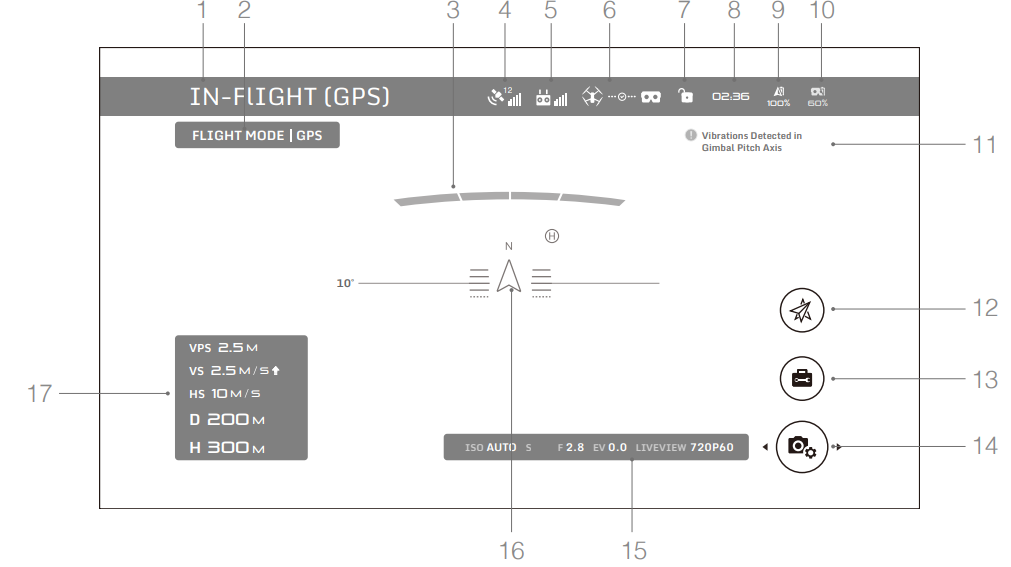
- Aircraft Status
Indicates the aircraft flight status. - Flight Mode
Indicates the current flight mode. - Obstacle Detection Status
Red bars are displayed when obstacles are close to the aircraft. Orange bars are displayed when obstacles are in the detection range. - GPS Status
Indicates the GPS signal strength. - Remote Controller Signal Strength
Indicates the strength of the remote controller signal. - Connection Status
Indicates the connection status of the aircraft and Goggles RE.
Green: Healthy signal connection.
Yellow: Weak or unstable signal connection.
Red: Disconnection. The Goggles RE will automatically attempt to reconnect if disconnected. - Touch Panel Lock Status
Indicates the lock status of the touch panel. A locked touch panel will be unresponsive to touch to avoid accidental control. Swipe forward with two fingers to unlock it. - Flight Time
Shows the flight time of the aircraft. - Aircraft Battery Level
Shows the current battery level of the Intelligent Flight Battery. - Goggles RE Battery Level
Shows the current battery level of the Goggles RE. - Prompt Message
Shows warning messages. Swipe up or down to select and tap to delete prompts. - Intelligent Flight Modes
Tap to select TapFly, ActiveTrack, Terrain Follow, Tripod, and other intelligent flight modes.
Tools
Tap to set the settings of the Goggles RE and select Auto Takeoff/Landing, HDMI video playback, or flight photos/videos playback.
The Settings menu also includes video tutorials, linking settings, language settings, volume settings, gimbal modes, AR auxiliary settings, and more.
Gimbal Mode
FPV Mode: The gimbal synchronizes with aircraft movement for a first-person flying experience.
Follow Mode: The gimbal keeps the camera steady, allowing for a stable and horizontal view. - AR Auxiliary Settings
Fixed-Wing Mode AR: Displays the aircraft's flight path in Fixed-Wing mode.
Head Tracking Gimbal AR Assist: Indicates the central position of the gimbal (front direction of the aircraft).
Head Tracking Flight AR Assist: Indicates the aircraft's yaw and throttle gain values. - Camera Settings/Shoot/Record Button
Tap to set the ISO, shutter, aperture, and auto exposure values of the camera.
Swipe left or right to switch between Shoot and Record mode. Tap to shoot photos or start/stop recording video.
Camera Parameters and Live View Mode*
Shows the setting parameters of the camera and Live View Mode. - Flight Attitude
The triangle indicates the direction the aircraft is facing.
The horizontal level indicates the aircraft's roll angle.
The scale indicates the tilt angle of the gimbal.
The arc beside the triangle indicates the yaw angle of the gimbal when Head Tracking Gimbal is enabled. - Flight Telemetry
Flight Telemetry shows the horizontal/vertical distance between the aircraft and the Home Point, as well as the movement speed across the horizontal/vertical distance of the aircraft. When the aircraft is close to the ground, the altitude will be displayed.
Live View Mode of the Goggles RE interacts with the aircraft’s video recording.
- When Live View Mode is in HD mode, video recording automatically switches to 1080p30.
- When in smooth mode, video recording automatically switches to 1080p60.
If you change the video recording mode of the aircraft, the live view of Goggles RE will preferentially synchronize with the matching format (1080p30 HD or 720p60 smooth mode). Otherwise, it will adjust Live View Mode to 720p30.
Digital Transmission Screen
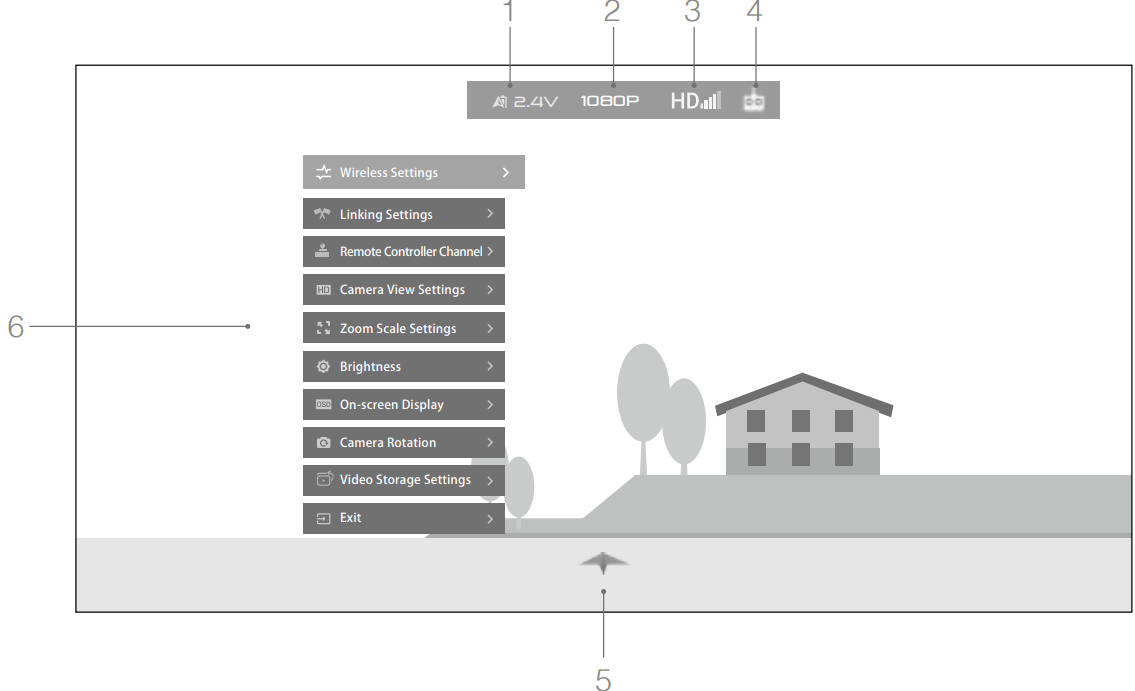
- Aircraft Voltage
- Shows the aircraft voltage read by the flight controller.
- Live View Mode
- Shows the current live view resolution.
- Video Downlink Signal Strength
- Indicates the strength of the video downlink between the Goggles RE and the DJI OcuSync Air System.
- Remote Controller Connection
- Indicates that the audio port of the Goggles RE is connected to the trainer port of a third-party remote controller through a trainer cable.
- Flight Attitude
- Indicates the aircraft’s roll and tilt angle during flight. Ensure that the UART input of the S.Bus port of the DJI OcuSync Air Unit is properly connected with the OSD output of the third-party flight controller.
- Menu Bar
- Tap the touch panel to call up the menu bar.
- Wireless Settings
Manual Mode: Bandwidth is 10 MHz, suitable for high-interference environments (e.g., with many wireless devices). The interference intensity of different channels will be displayed, and it is recommended to use a green channel, which indicates lower interference.
Auto Mode: Bandwidth is 20 MHz, suitable for low-interference environments, providing enhanced quality for live view. - Linking Settings
Links Goggles RE or a remote controller with the DJI OcuSync Air System wirelessly. A variety of connection modes are supported. - Remote Controller Channel
Displays up to 8 channels of the remote controller output for debugging. Ensure that the S.Bus port of the DJI OcuSync Air Unit is properly connected with the OSD output of the third-party flight controller, and that the Goggles RE’s audio port is connected to the trainer port of a third-party remote controller. - Camera View Settings
Supports 1280×960, 1280×720, and 640×480 live view modes. - On-screen Display
Enables/disables the Image Transmission signal, Image Transmission Resolution, and Flight Attitude on-screen displays separately. - Camera Rotation
Rotates the live view and recorded video by 180° to suit special installation or shooting needs. - Video Storage Settings
- Wireless Settings
- Tap the touch panel to call up the menu bar.
Enables/disables saving recorded video to the Micro SD card on the DJI OcuSync Air Unit or Goggles RE separately. Tap the Function Button on Goggles RE to start/stop video recording. Video saved on the Micro SD card of the DJI OcuSync Air Unit can be connected to a computer for browsing but cannot be viewed in “Aircraft Storage”. Videos saved on the Goggles RE can be played in "Local Storage".
Controlling the Aircraft
The functional support list of the Goggles RE, when connected with different aircraft, is shown below.*
Mavic 2 Series** |
Mavic Pro | Phantom 4 Pro/Pro+V2.0 |
Mavic Air |
Spark | Phantom 4 Pro/ Advanced Series |
Phantom 4 |
Inspire 2 | Inspire 1 Series | |
Head Tracking Flight | √ | √ | √ | √ | √ | √ | √ | √ | × |
Head Tracking Gimbal | √ | √ | √ | √ | √ | √ | √ | √ | × |
Focus | √ | √ | √ | × | × | √ | × | √ | × |
Auto Takeoff / Return-to-Home | √ | √ | √ | √ | √ | √ | √ | × | × |
TapFly | √ | √ | √ | √ | √ | √ | √ | × | × |
ActiveTrack | √ | √ | √ | √ | √ | √ | √ | × | × |
Terrain Follow | × | √ | √ | × | × | √ | √ | × | × |
Tripod | × | √ | √ | × | √ | √ | × | × | × |
Cinematic | × | √ | √ | × | × | × | × | × | × |
Fixed-Wing | × | √ | × | × | × | × | × | × | × |
Some functions will be supported later; please pay attention to future updates.
Mavic 2 Enterprise and Mavic 2 Enterprise Dual are not included.
When linked to the Mavic 2 series or Mavic Pro, the remote controller can be used to control the Goggles RE.
- 5D button = Touch Panel
- C1 button = Function Button
- C2 button = Back Button
Press the C1 and C2 buttons together to enter the shortcut menu, and press the C2 button to exit. These remote controller buttons will be used to control the Goggles RE, and their original function will be disabled. Please fly with caution.
Intelligent Flight Modes
Goggles RE support DJI Intelligent Flight Modes such as TapFly, ActiveTrack, Terrain Follow, Tripod, Fixed-Wing, and more. Refer to the aircraft user manual for further details.
Use the touch panel to enter Intelligent Flight Mode and select the corresponding button to enable the desired mode. Enable TapFly, ActiveTrack, or Fixed-Wing in the Goggles RE as follows:
TapFly
- Use the touch panel to enter “Intelligent Flight Mode > TapFly”.
- Move your head to control the cursor in the Goggles RE and then tap the touch panel to confirm the target direction and wait for the
 icon to appear.
icon to appear. - Tap again to confirm the selection, and the aircraft will fly in that direction.
- Press the back button on the Goggles RE to exit the current target direction or TapFly.
ActiveTrack
- Use the touch panel to enter “Intelligent Flight Mode > ActiveTrack”.
- Move your head to control the cursor in the Goggles RE and then tap the touch panel to select the target subject. If the subject is not automatically recognized, move your head from the upper left corner to the lower right corner to drag a box around it. The box will turn green when tracking is in progress. If the box turns red, the object could not be identified and you should try again.
- Tap again to confirm the selection, and the aircraft will track the target subject.
- Press the back button on the Goggles RE to exit the current target subject or ActiveTrack.
Fixed-Wing
- Use the touch panel to enter “Intelligent Flight Mode > Fixed-Wing”.
- When the forward speed of the aircraft is more than 3 m/s, you can select to enter a Fixed-Wing cruise option. Press the function button or tap the touch panel on the Goggles RE to enter Fixed-Wing Mode.
- Press the back button on the Goggles RE to exit Fixed-Wing Mode.
Shortcut Menu
Swipe downward with two fingers on the touch panel to enter the shortcut menu. Move the cursor and tap the touch panel to turn functions on/off. The Goggles RE support head tracking, which allows the aircraft to follow head movements:
- Head Tracking Flight
- Move your head to control the aircraft and the gimbal. Turn left and right to control the yaw of the aircraft, and turn up and down to control the pitch of the gimbal (-90° to 30°).
- Head Tracking Gimbal
- Move your head to control the gimbal. Turn left and right to control the yaw of the gimbal (-30° to 30°), and turn up and down to control the pitch of the gimbal (-90° to 30°).
- Reset Motion Control
- Set the gimbal to the center position or simulate the yaw stick in the mid-point of the remote controller. Head tracking will center on this point. You can set the head tracking sensitivity in the Tools setting.
Warning: When Head Tracking is enabled (especially Head Tracking Flight), the aircraft yaw or gimbal movement will be affected. Please fly with caution and pay attention to control with the remote controller.
It is recommended to use a 720p60 high frame rate format to ensure a smooth live view during fast movements. The functions in the shortcut menu are disabled when using TapFly and ActiveTrack. Only Head Tracking Flight can be enabled when using Fixed-Wing Mode. This head tracking function should be enabled before entering the Fixed-Wing cruise option, and your head should be kept stable at that time.
Viewing Photos and Videos
Review your flight videos and photos, use your head and body movement to view panoramas, and watch HD video content through the Goggles RE for an immersive viewing experience.
Flight Photos and Videos
Select “Tools > Playback” to enter the playback page for flight photos and videos (shot by DJI aircraft only), or demo videos.

DJI Goggles Racing Edition Local Storage
Remove the Micro SD card from the aircraft and insert it into the Micro SD Card slot on the Goggles RE, and then select “Local Storage”.
Aircraft Storage
Select “Aircraft Storage” to preview images stored on the aircraft. When you are browsing photos or videos, you can swipe up/down with one finger to download or delete them.
Panorama
Goggles RE support panorama picture-browsing with up to 6000×3000 resolution (only sphere panorama is currently supported). You can move your head and body to view all parts of the 360° panoramic view. To browse panoramas:
- Local Storage — Insert the Micro SD card containing the panorama into the Micro SD card slot of Goggles RE, then preview it in “Local Storage”.
- Download from Aircraft Storage — In the DJI GO 4 main screen, enter “Playback > Photo” and select a panorama, tap to synchronize it to the aircraft. When synchronization is complete, you will see a thumbnail of the panorama in the “Aircraft Storage” on Goggles RE. Make sure that Goggles RE is connected with the remote controller, download the panorama to Goggles RE, and then you can browse it in “Local Storage”.
When you select the panorama from the Playback page on Goggles RE, you will first access a thumbnail. Tap the touch panel again to enter the full 360° view.
Warning
- Only 720p and 1080p videos recorded by the aircraft can be played from Local Storage or Aircraft Storage.
- Playback is only supported by the Mavic series, Spark, and Phantom 4 Pro/Advanced series aircrafts. Ensure the Micro SD card is inserted into the Goggles RE when downloading photos/videos. After that, you can browse them in “Local Storage”.
- When browsing the photos and videos in “Local Storage”, store the files in the Micro SD card according to the directory below:
- Videos: DJI_VIDEO in the root directory
- Photos: DJI_PHOTO in the root directory
- Panoramas: DJI_PANO in the root directory
Additional Warning
- Ensure to use the Panorama feature when the aircraft’s motors are turned off.
- When using the Goggles RE with the Mavic Pro, if a user plays the video from aircraft storage instead of having a live view, the video will be displayed on all devices synchronously. DO NOT play aircraft storage videos during flight to ensure safety.
Video Play
Goggles RE support both Micro SD card and HDMI connection to view HD video. For HD video playback:
- Micro SD Card — Insert the Micro SD card containing the HD video into the Micro SD card slot of Goggles RE, then select “Tools > Playback > Local Storage”.
- HDMI — Connect the video source to Goggles RE with an HDMI cable and select “Tools > HDMI Input”.
During video playback, swipe up/down on the touch panel with one finger to adjust the volume. Swipe left/right with two fingers for high-speed scrubbing through the video, and with one finger for fine scrubbing.
Micro SD card video playback is compatible with MP4, MOV, and MKV formats.
Charging the Goggles RE
- Connect the battery charger to a power outlet (100-240 V, 50/60 Hz).
With the Goggles RE powered off, connect the charging port on the headband to the charger with the Micro USB cable included.

- The charging status indicator will go solid red, yellow, and green in that order when charging. The battery level indicators will blink green, indicating current battery levels.
The battery is fully charged when the charging status indicator or battery level indicators turn off. Disconnect the Goggles RE from the charger.

Important Safety Information
- DO NOT charge the Goggles RE when it is powered on to ensure safety.
- When using a non-standard charger, the maximum output voltage must not exceed 12 V.
- The Goggles RE battery is located in the headband. You can connect the headband individually to the charger for charging. The battery is fully charged when the charging status indicator turns off.
- A standard charger is recommended for charging. It takes approximately four hours to fully charge the battery. Other chargers may take longer.
- The Goggles RE and the standard charger feature Qualcomm Quick Charge 3.0 technology.
Setup Guide
To operate the DJI Goggles Racing Edition, follow these steps:
- Charge the goggles fully before first use.
- Power on the goggles and pair them with your DJI drone or transmitter using the DJI GO app or the Go 4 app.
- Adjust the interpupillary distance to fit your eyes comfortably.
- Ensure that your drone is configured correctly for FPV mode through the app settings.
- Start your flight and adjust any settings as needed from within the goggles menu.
Upgrading Firmware
DJI Assistant 2
Use DJI Assistant 2 to upgrade the Goggles RE.
- Power on the Goggles RE and connect them to a computer with a Micro USB cable.
- Launch DJI Assistant 2 and log in with a registered DJI account.
- Select “Goggles RE” and click “Firmware Upgrade” on the left-hand side.
- Select the firmware version required.
- DJI Assistant 2 will download and upgrade the firmware automatically.
- Restart the Goggles RE after the firmware upgrade is complete.
Use DJI Assistant 2 to upgrade the aircraft and remote controller of the Mavic Pro and the Goggles RE simultaneously (only supports connection topology for Standard Mode).
- Ensure all devices are powered on and that the aircraft is linked with the remote controller.
- Connect the remote controller to a computer with a Micro USB cable.
- Launch DJI Assistant 2 and log in with a registered DJI account.
- Select “RC for Mavic Pro” and click “Firmware Upgrade” on the left-hand side.
- Select the required firmware version.
- DJI Assistant 2 will download and upgrade the firmware automatically.
- Restart all devices when the firmware upgrade is complete.
Use DJI Assistant 2 to upgrade the DJI OcuSync Air Unit.
- When the DJI OcuSync Air Unit is powered on, connect it to a computer with a Micro USB cable.
- Launch DJI Assistant 2 and log in with a registered DJI account.
- Select “DJI OcuSync Air Unit” and click “Firmware Upgrade” on the left-hand side.
- Select the firmware version required.
- DJI Assistant 2 will download and upgrade the firmware automatically.
- Restart the Air Unit after the firmware upgrade is complete.
DJI GO 4 App
Use the DJI GO 4 app to upgrade the aircraft and remote controller of the Mavic Pro and the Goggles RE simultaneously (only supports connection topology for Standard Mode).
- Ensure all devices are powered on and that the aircraft is linked with the remote controller.
- Connect the remote controller with the DJI GO 4 app. A prompt will appear if a new firmware upgrade is available. To start upgrading, connect a mobile device to the Internet and follow the on-screen instructions.
- Restart all devices when the firmware upgrade is complete.
Cleaning and Maintenance
Be sure to unplug the charger from the power outlet before cleaning and ensure that there are no cables connected.
Cleaning the Goggles RE
- Wipe and clean the surface of the Goggles RE with a soft clean cloth.
- To clean the facial pad, first drag it from the left or right side to the inside, then detach the other parts. Run water over the facial pad, then wipe it with a soft, dry cloth until it is completely dry.
Align the protruding part of the facial pad with the holes on the Goggles RE body, then press them together so they are securely attached.
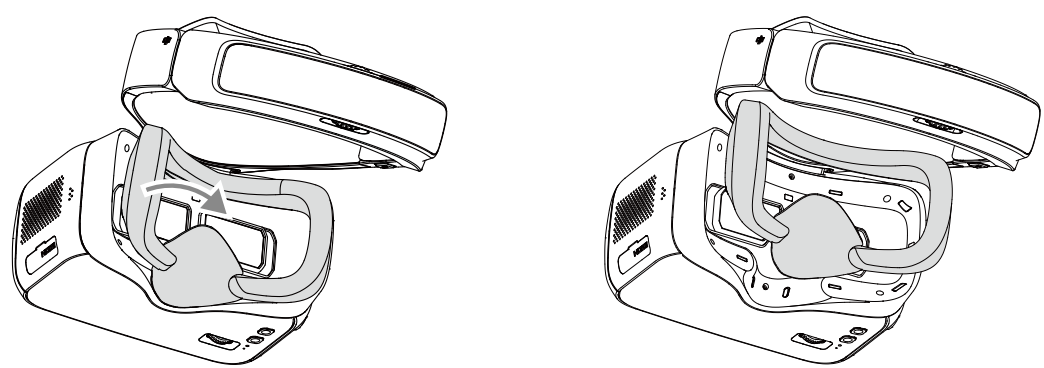
Maintenance of Lenses
- Use the cleaning cloth included to wipe the lenses gently.
- Moisten the cleaning cloth with alcohol or a lens cleaner.
- Wipe in a circular motion from the center to the outer edges of the lenses.
DO NOT clean the headband padding with alcohol. The lenses are delicate, please clean them gently. DO NOT scratch them as this will damage the overall viewing experience. Store the Goggles RE in a dry room at room temperature to avoid damage to the lenses from high temperature and humid environments.
Troubleshooting
Common issues and solutions include:
- No Signal: Check that your drone and transmitter are powered on and properly paired with the goggles.
- Blurry Vision: Adjust the focus wheel or interpupillary distance to ensure proper alignment with your eyes.
- Audio Issues: Ensure that speakers are not muted and volume is turned up; check for any blockages in the speakers.
Instructions & Warnings: Always follow safety guidelines when flying drones; ensure proper ventilation when wearing goggles for extended periods.
Pros & Cons
Pros
- High-Definition Display: Offers an immersive FPV experience with high resolution screens.
- Low Latency: Ensures real-time video feed essential for competitive drone racing.
- Comfortable Design: Ergonomic fit reduces fatigue during long flights.
- Compatibility: Works seamlessly with various DJI drones and transmitters.
Cons
- Cost: Pricier compared to some other FPV goggles on the market.
- Weight: May feel heavy after prolonged use due to its robust build.
- Battery Life: While decent, may not suffice for very long flights or extended usage without recharging.
Customer Reviews
Customers have praised the DJI Goggles Racing Edition for its exceptional video quality and low latency, making it a favorite among competitive drone racers. Some common complaints include the weight of the goggles and the cost, but overall satisfaction remains high due to its performance and durability.
Faqs
What is the resolution of the screens in DJI Goggles Racing Edition?
How do I pair my DJI Goggles Racing Edition with my drone?
What is the battery life of DJI Goggles Racing Edition?
Can I use DJI Goggles Racing Edition with non-DJI drones?
How do I adjust focus on DJI Goggles Racing Edition?
Are there any safety precautions I should take while using DJI Goggles Racing Edition?
Can I wear glasses while using DJI Goggles Racing Edition?
What kind of audio does DJI Goggles Racing Edition support?
How do I clean my DJI Goggles Racing Edition?
Is there an SDK available for customizing my experience with DJI Goggles Racing Edition?
Leave a Comment
